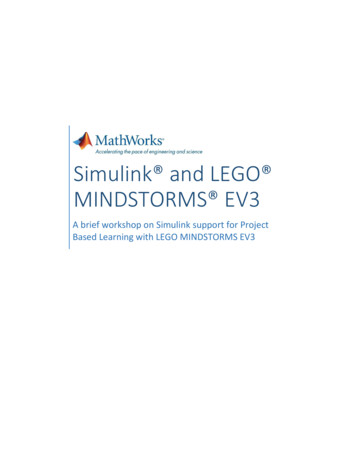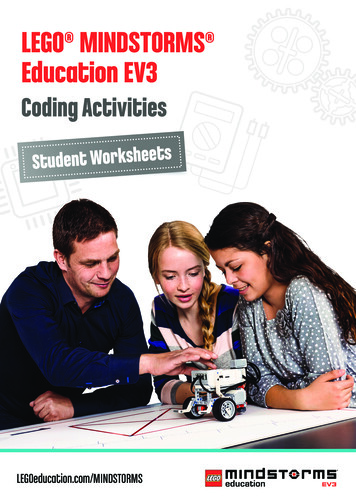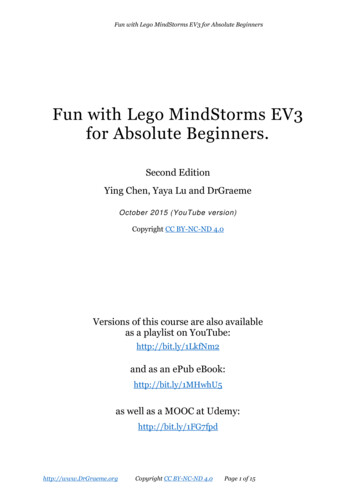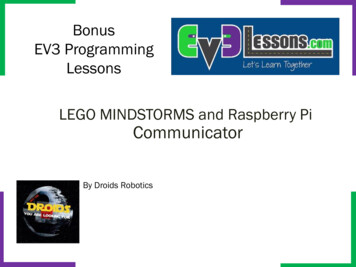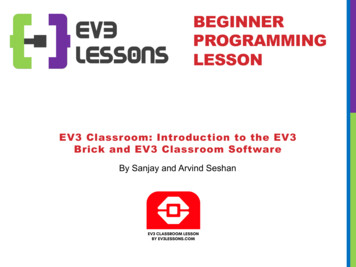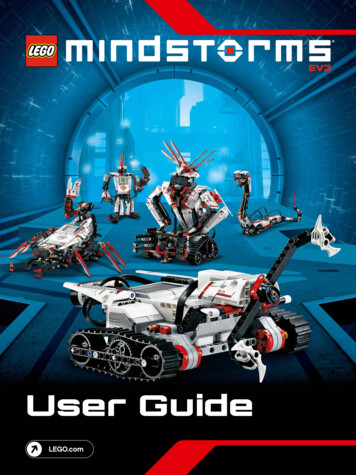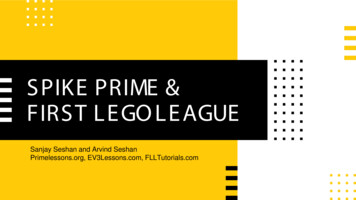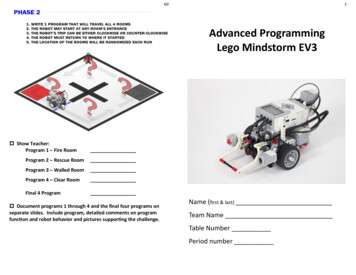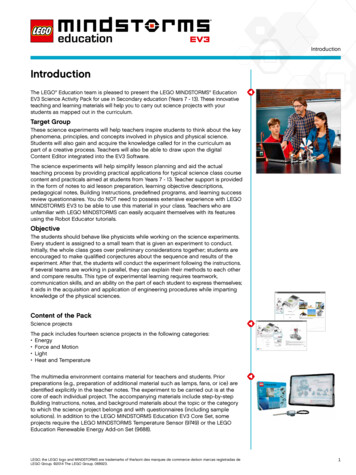
Transcription
IntroductionIntroductionThe LEGO Education team is pleased to present the LEGO MINDSTORMS EducationEV3 Science Activity Pack for use in Secondary education (Years 7 - 13). These innovativeteaching and learning materials will help you to carry out science projects with yourstudents as mapped out in the curriculum.Target GroupThese science experiments will help teachers inspire students to think about the keyphenomena, principles, and concepts involved in physics and physical science.Students will also gain and acquire the knowledge called for in the curriculum aspart of a creative process. Teachers will also be able to draw upon the digitalContent Editor integrated into the EV3 Software.The science experiments will help simplify lesson planning and aid the actualteaching process by providing practical applications for typical science class coursecontent and practicals aimed at students from Years 7 - 13. Teacher support is providedin the form of notes to aid lesson preparation, learning objective descriptions,pedagogical notes, Building Instructions, predefined programs, and learning successreview questionnaires. You do NOT need to possess extensive experience with LEGOMINDSTORMS EV3 to be able to use this material in your class. Teachers who areunfamiliar with LEGO MINDSTORMS can easily acquaint themselves with its featuresusing the Robot Educator tutorials.ObjectiveThe students should behave like physicists while working on the science experiments.Every student is assigned to a small team that is given an experiment to conduct.Initially, the whole class goes over preliminary considerations together; students areencouraged to make qualified conjectures about the sequence and results of theexperiment. After that, the students will conduct the experiment following the instructions.If several teams are working in parallel, they can explain their methods to each otherand compare results. This type of experimental learning requires teamwork,communication skills, and an ability on the part of each student to express themselves;it aids in the acquisition and application of engineering procedures while impartingknowledge of the physical sciences.Content of the PackScience projectsThe pack includes fourteen science projects in the following categories: Energy Force and Motion Light Heat and TemperatureThe multimedia environment contains material for teachers and students. Priorpreparations (e.g., preparation of additional material such as lamps, fans, or ice) areidentified explicitly in the teacher notes. The experiment to be carried out is at thecore of each individual project. The accompanying materials include step-by-stepBuilding Instructions, notes, and background materials about the topic or the categoryto which the science project belongs and with questionnaires (including samplesolutions). In addition to the LEGO MINDSTORMS Education EV3 Core Set, someprojects require the LEGO MINDSTORMS Temperature Sensor (9749) or the LEGOEducation Renewable Energy Add-on Set (9688).LEGO, the LEGO logo and MINDSTORMS are trademarks of the/sont des marques de commerce de/son marcas registradas deLEGO Group. 2014 The LEGO Group. 068923.1
IntroductionScience ProjectsEach project revolves around an experiment-based assignment. The assignment isorganized through the Content Editor integrated into the EV3 Software, whose featuresenable multimedia presentation, interaction, and documentation. It includes thefollowing features, among others: I mages of the structure of the experiment, both in the form of general overviewsand at the detailed level Notes on how to build or use the models Tables to facilitate the structuring and organization of test data and observations Data logging tools for sensor data analysis (measured values) S oftware buttons that make it easy to add video clips, photos, and other images aswell as text, audio recordings, and webcam recordings.Every project for students contains the following pages related to the experimentationprocess: IntroductionPreliminary ConsiderationsBuilding InstructionsDownload ProgramNotes on Using the ModelExperiment – MeasureAnalyseWhat Did We Measure and What Did We Find Out?This Is What We LearnedOn to New DiscoveriesIntroductionScience Projects (overview)EnergyForce and MotionLightHeat and TemperatureEnergy TransferGearsLight IntensityFreezing andThermal InsulationWind EnergyInclined PlaneHeat TransferSolar EnergyFrictionConvectionEnergy EfficiencyVelocityElectric VehiclesAcceleration of GravityLEGO, the LEGO logo and MINDSTORMS are trademarks of the/sont des marques de commerce de/son marcas registradas deLEGO Group. 2014 The LEGO Group. 068923.6The Learning Success Review can be performed using questionnaires handed out bythe teacher.While working on the science projects, pages with teacher notes will be displayed inTeacher Mode. These will include: Information About the ProjectLearning ObjectivesTeacher NotesLesson PreparationNotes on Preliminary ConsiderationsExperiment – MeasureAnalyseReviewReportLearning Success ReviewIn addition, the teacher notes include comments, warnings, suggestions for furtherexperiments, and other helpful material.Click the button to toggle between thestudent pages and the teachers' notes.LEGO, the LEGO logo and MINDSTORMS are trademarks of the/sont des marques de commerce de/son marcas registradas deLEGO Group. 2014 The LEGO Group. 068923.2
IntroductionLesson SequenceSelect the Science option in the EV3 Software menu.1. Choose between the categories Energy, Force and Motion, Light, or Heat andTemperature and select one of the projects offered.2. Read the page with Information About the Project to learn what grade level(s)the project is suitable for, how much time to allow for the experiment, and whattechnical prerequisites are required. The next two pages contain information aboutthe learning objectives and pedagogical methods. The Lesson Preparation pagehas additional information that you should consider before having the class conductthe experiment.3. The next page provides Building Instructions for the model required in the experimentyou selected. The next step is to build the model or to have the students build it.Most experiments will now require you to download the program as well.4. Next, carry out the experiment according to the instructions. The instructionsmay vary from experiment to experiment. Some experiments involve producingmeasurement series whose values are shown on the EV3 Brick display, and someof the values measured will need to be entered in data tables.5. Observations made while conducting the experiment should then be analyzed;encourage the students to enter comments in the field provided for this purpose.6. Now the students document the experiment by summarizing their results, enteringinformation in the appropriate field.7. The students describe what they have learned (physical phenomena), enteringtheir information in the appropriate field.Lesson Organization TipsTime requiredThe time required by the individual projects depends on a range of factors, includingthe students' age, their prior experience with LEGO MINDSTORMS , the complexityof the experiment, and the scope of the topic addressed by the project in question.There are four categories containing different numbers of projects. These categoriescorrespond to the curriculum established for science in Years 7 - 13. Every experimentincludes possible variations and options for further investigation. There are no standardsolutions that would suggest an exact time allowance. The forty-five-minute time allotmentis an approximate indication of how much time an average student will need to buildthe model according to the Building Instruction and then carry out the experiment.The time allotment does not include the time required for documentation or the LearningSuccess Review, since these may vary considerably depending on the students'capabilities and the demands placed on them by the teacher.There is additional teaching material available in accompanying PDF files for the topicsexplored through the fourteen science projects. This material consists of backgroundknowledge, definitions, relevant equations, historical facts, ties to modern developments,and inspiration for student research topics. Also included in this material are questionsyou can use as pre- or post-assessments for the broad range of topics linked withthe fourteen science projects. Explore this material before using it with your studentsto ensure it meets your teaching objectives.LEGO, the LEGO logo and MINDSTORMS are trademarks of the/sont des marques de commerce de/son marcas registradas deLEGO Group. 2014 The LEGO Group. 068923.3
IntroductionThe projects are distributed over the four categories as follows:Energy Energy Transfer Wind Energy Solar Energy Energy Efficiency Electric VehiclesForce and Motion Gears Inclined Plane Friction Velocity Acceleration of GravityLight Light IntensityHeat and Temperature Freezing and Thermal Insulation Heat Transfer ConvectionIf you do not have a double period available for the project, the digital tools will helpstudents save the current status of their work so that they can resume work on theirprojects in the next lesson. Students are encouraged to present their work to classmatesby having to document the work process and their results. For example, you can askeach team of students to present its own project or discuss the projects in a largergroup or as an entire class. This will allow students to compare their experiences anddiscuss the reasons behind differing results. One of the main lessons the studentswill learn in the physics projects is that no solution is perfect. Every experiment issubject to disruptive factors or unplanned side effects that may skew the results.Tying the Tutorials Provided in the Robot Educator into the ScienceProjectsThe EV3 Software Lobby contains a Robot Educator with a total of forty-eight tutorials.If the students have no prior experience with the EV3 Software, we recommend workingthrough at least a few relevant learning units in the Robot Educator before moving onto the physics experiments. The Data Logging involved in numerous experiments isparticularly important.Some teachers ask their students to work through a few of the tutorials before theyare allowed to start building the models. Other teachers inform the class about whathardware and software is available while the students are building their models. Bothmethods will lead to the desired outcome.It is a good idea to go over the menus in the Robot Educator in detail so that thestudents are familiar with the overall structure and content of the tutorials, so thatthey will know how to locate information there.If you prefer to begin by having the students work through the Robot Educator tutorialsbefore starting the physics projects, you can find more detailed information in thePDF document Robot Educator – Introduction that is located under the Teacher’sGuide section of Robot Educator.LEGO, the LEGO logo and MINDSTORMS are trademarks of the/sont des marques de commerce de/son marcas registradas deLEGO Group. 2014 The LEGO Group. 068923.4
IntroductionContent EditorCustomized instructionsThe Content Editor gives you the power to customize the project files included in thescience projects, allowing you to create lessons tailored to your class's particular needs.Here are some of the things that you can do: Adapt the text to better match your students' reading comprehension skills Add pictures that are more relevant to your students Modify the assignments to make them easier or more difficult C hange the project objectives to either expand or narrow the range of potentialexperiments Formulate your own project objectives or assignments Add your own evaluation categories or evaluation toolsTo ensure that you do not overwrite the files included in the science projects, anychanges made are saved as a new project. All of the files included in the originalproject will also be transferred into the new project file so that you can then makethem available to the students ((e.g., on a shared network drive).The Content Editor can be used to document progress, findings, and results whileworking through the respective project. It allows students to c ompose descriptions of their group discussions, methods employed, observations,results, and reflections; enter their data in tables; p ost audio recordings of their ongoing work on the experiment and recordingsrelated to their discussions and experimental methods; add their own pages; add images and videos showing their own models in action; publish their unique projects and share them with fellow students.More information about the Content Editor is available in the Quick Start videos(open the video called Content Editor) and in the User Guide located under QuickStart in the EV3 Software Lobby.LEGO, the LEGO logo and MINDSTORMS are trademarks of the/sont des marques de commerce de/son marcas registradas deLEGO Group. 2014 The LEGO Group. 068923.5
IntroductionScience Projects (overview)EnergyForce and MotionLightHeat and TemperatureEnergy TransferGearsLight IntensityFreezing andThermal InsulationWind EnergyInclined PlaneHeat TransferSolar EnergyFrictionConvectionEnergy EfficiencyVelocityElectric VehiclesAcceleration of GravityLEGO, the LEGO logo and MINDSTORMS are trademarks of the/sont des marques de commerce de/son marcas registradas deLEGO Group. 2014 The LEGO Group. 068923.6
Building Instructions, notes, and background materials about the topic or the category to which the science project belongs and with questionnaires (including sample solutions). In addition to the LEGO MINDSTORMS Education EV3 Core Set, some projects require the LEGO MINDSTORMS Temperature Sensor (9749) or the LEGO
